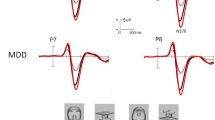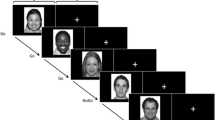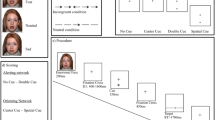Abstract
Emotionally biased information processing towards sad and away from happy information characterises individuals with major depression. To learn more about the nature of these dysfunctional modulations, developmental and neural aspects of emotional face processing have to be considered. By combining measures of performance (attention control, inhibition) in an emotional Go/NoGo task with an event-related potential (ERP) of early face processing (N170), we obtained a multifaceted picture of emotional face processing in a sample of children and adolescents (11–14 years) with major depression (MDD, n = 26) and healthy controls (CTRL, n = 26). Subjects had to respond to emotional faces (fearful, happy or sad) and withhold their response to calm faces or vice versa. Children of the MDD group displayed shorter N170 latencies than children of the CTRL group. Typical right lateralisation of the N170 was observed for all faces in the CTRL but not for happy and calm faces in the MDD group. However, the MDD group did not differ in their behavioural reaction to emotional faces, and effects of interference by emotional information on the reaction to calm faces in this group were notably mild. Although we could not find a typical pattern of emotional bias, the results suggest that alterations in face processing of children with major depression can be seen at early stages of face perception indexed by the N170. The findings call for longitudinal examinations considering effects of development in children with major depression as well as associations to later stages of processing.






Similar content being viewed by others
Abbreviations
- MDD:
-
Major depression
- CTRL:
-
Healthy controls
- EEG:
-
Electroencephalography
- ERP:
-
Event-related potential
- RT:
-
Reaction time
- CE:
-
Commission errors
References
Ashley V, Vuilleumier P, Swick D (2004) Time course and specificity of event-related potentials to emotional expressions. NeuroReport 15(1):211–216
Bar-Haim Y, Lamy D, Glickman S (2005) Attentional bias in anxiety: A behavioral and ERP study. Brain Cogn 59(1):11–22
Batty M, Taylor MJ (2003) Early processing of the six basic facial emotional expressions. Cognitive Brain Res 17(3):613–620
Batty M, Taylor MJ (2006) The development of emotional face processing during childhood. Dev Sci 9(2):207–220
Beck AT, Rush AJ, Shaw BF, Emery G (1979) Cognitive therapy of depression. Guildford, New York
Bentin S, Allison T, Puce A, Perez E, McCarthy G (1996) Electrophysiological studies of face perception in humans. J Cognitive Neurosci 8(6):551–565
Blau VC, Maurer U, Tottenham N, McCandliss BD (2007) The face-specific N170 component is modulated by emotional facial expression. Behav Brain Funct 3:7
Brunet D, Murray MM, Michel CM (2011) Spatiotemporal analysis of multichannel EEG: CARTOOL. Comput Intell Neurosci 2011(813870):1–15. doi:10.1155/2011/813870
Campanella S, Quinet P, Bruyer R, Crommelinck M, Guerit J (2002) Categorical perception of happiness and fear facial expressions: an ERP study. J Cognitive Neurosci 14(2):210–227
Cavanagh J, Geisler MW (2006) Mood effects on the ERP processing of emotional intensity in faces: a P3 investigation with depressed students. Int J Psychophysiol 60(1):27–33
Craske MG (2003) Origins of phobias and anxiety disorders: why more women than men?. Elsevier, Amsterdam
Dai Q, Feng Z (2012) More excited for negative facial expressions in depression: evidence from an event-related potential study. Clin Neurophysiol 123(11):2172–2179
Deldin PJ, Keller J, Gergen JA, Miller GA (2000) Right-posterior face processing anomaly in depression. J Abnorm Psychol 109(1):116–121
Delmo C, Weiffenbach O, Gabriel M, Stadler C, Poustka F (2001) Diagnostisches Interview-Kiddie-Sads-present and lifetime Version (K-SADS-PL).-5. Auflage der deutschen Forschungsversion, erweitert um ICD-10-Diagnostik [5th edition of the German research version with the addition of ICD-10-diagnosis]. Klinik für Psychiatrie und Psychotherapie des Kindes- und Jugendalters, Frankfurt.
Deveney CM, Deldin PJ (2004) Memory of faces: a slow wave ERP study of major depression. Emotion 4(3):295–304
Eimer M, Holmes A (2002) An ERP study on the time course of emotional face processing. NeuroReport 13(4):427–431
Feuerriegel D, Churches O, Hofmann J, Keage HAD (2015) The N170 and face perception in psychiatric and neurological disorders: a systematic review. Clin Neurophysiol 126(6):1141–1158. http://dx.doi.org/10.1016/j.clinph.2014.09.015
Foti D, Olvet DM, Klein DN, Hajcak G (2010) Reduced electrocortical response to threatening faces in major depressive disorder. Depress Anxiety 27(9):813–820
Gainotti G (2013) Laterality effects in normal subjects' recognition of familiar faces, voices and names. Perceptual and representational components. Neurophysiol 51(7): 1151–1160
Goodman R, Meltzer H, Bailey V (1998) The strengths and difficulties questionnaire: a pilot study on the validity of the self-report version. Eur Child Adolesc Psy 7(3):125–130
Gotlib IH, Kasch KL, Traill S, Joormann J, Arnow BA, Johnson SL (2004a) Coherence and specificity of information-processing biases in depression and social phobia. J Abnorm Psychol 113(3):386–398
Gotlib IH, Krasnoperova E, Yue DN, Joormann J (2004b) Attentional biases for negative interpersonal stimuli in clinical depression. J Abnorm Psychol 113(1):121–135
Hadwin JA, Garner M, Perez-Olivas G (2006) The development of information processing biases in childhood anxiety: a review and exploration of its origins in parenting. Clin Psychol Rev 26(7):876–894
Hare TA, Tottenham N, Davidson MC, Glover GH, Casey BJ (2005) Contributions of amygdala and striatal activity in emotion regulation. Biol Psychiat 57(6):624–632
Herba C, Phillips M (2004) Annotation: Development of facial expression recognition from childhood to adolescence: behavioural and neurological perspectives. J Child Psychol Psyc 45(7):1185–1198
Hill AB, Dutton F (1989) Depression and selective attention to self-esteem threatening words. Pers Indiv Differ 10(8):915–917
Holmes A, Vuilleumier P, Eimer M (2003) The processing of emotional facial expression is gated by spatial attention: evidence from event-related brain potentials. Cognitive Brain Res 16(2):174–184
Jaworska N, Blier P, Fusee W, Knott V (2012) The temporal electrocortical profile of emotive facial processing in depressed males and females and healthy controls. J Affect Disord 136(3):1072–1081
Joormann J, Talbot L, Gotlib IH (2007) Biased processing of emotional information in girls at risk for depression. J Abnorm Psychol 116(1):135–143
Kaufman J, Birmaher B, Brent B, Rao U, Ryan ND (1996) Kiddie-Sads-Present and Lifetime Version (K-SADS-PL), Version 1.0 of October 1996. The Department of Psychiatry, University of Pittsburgh School of Medicine, Pittsburgh, PA
Kayser J, Bruder GE, Tenke CE, Stewart JE, Quitkin FM (2000) Event-related potentials (ERPs) to hemifield presentations of emotional stimuli: differences between depressed patients and healthy adults in P3 amplitude and asymmetry. Int J Psychophysiol 36(3):211–236
Kemp A, Hopkinson PJ, Hermens DF, Rowe DL, Sumich AL, Clark CR, Drinkenburg W, Abdi N, Penrose R, McFarlane A (2009) Fronto-temporal alterations within the first 200 ms during an attentional task distinguish major depression, non-clinical participants with depressed mood and healthy controls: a potential biomarker? Hum Brain Mapp 30(2):602–614
Kindt M, van Den Hout M (2001) Selective attention and anxiety: a perspective on developmental issues and the causal status. J Psychopathol Behav 23(3):193–202
Krombholz A, Schaefer F, Boucsein W (2007) Modification of N170 by different emotional expression of schematic faces. Biol Psychol 76(3):156–162
Kuefner D, Heering A de, Jacques C, Palmero-Soler E, Rossion B (2009) Early visually evoked electrophysiological responses over the human brain (P1, N170) show stable patterns of face-sensitivity from 4 years to adulthood. Front Hum Neurosci 3
Kujawa AJ, Torpey D, Kim J, Hajcak G, Rose S, Gotlib IH, Klein DN (2011) Attentional biases for emotional faces in young children of mothers with chronic or recurrent depression. J Abnorm Child Psych 39(1):125–135
Ladouceur CD, Dahl RE, Williamson DE, Birmaher B, Axelson DA, Ryan ND, Casey BJ (2006) Processing emotional facial expressions influences performance on a Go/NoGo task in pediatric anxiety and depression. J Child Psychol Psyc 47(11):1107–1115
Lehmann D (1987) Principles of spatial analysis. In: Gevins AS, Rémond A (eds) Handbook of electroencephalography and clinical neurophysiology 1: methods of analysis of brain electrical and magnetic signals (revised series). Elsevier, Amsterdam, pp 309–354
Leppänen JM (2006) Emotional information processing in mood disorders: a review of behavioral and neuroimaging findings. Curr Opin Psychiatr 19(1):34–39
Lonigan CJ, Vasey MW, Phillips BM, Hazen RA (2004) Temperament, anxiety, and the processing of threat-relevant stimuli. J Clin Child Adolesc 33(1):8–20
MacLeod C, Mathews A, Tata P (1986) Attentional bias in emotional disorders. J Abnorm Psychol 95(1):15–20
Mathews A, MacLeod C (2005) Cognitive vulnerability to emotional disorders. Annu Rev Clin Psycho 1:167–195
Maurage P, Campanella S, Philippot P, de Timary P, Constant E, Gauthier S, Miccichè M, Kornreich C, Hanak C, Noël X (2008) Alcoholism leads to early perceptive alterations, independently of comorbid depressed state: an ERP study. Neurophysiologie Clinique/Clinical Neurophysiology 38(2):83–97
McClure EB (2000) A meta-analytic review of sex differences in facial expression processing and their development in infants, children, and adolescents. Psychol Bull 126(3):424–453
McNeely HE, Lau MA, Christensen BK, Alain C (2008) Neurophysiological evidence of cognitive inhibition anomalies in persons with major depressive disorder. Clin Neurophysiol 119(7):1578–1589
Mogg K, Bradley BP, Williams R (1995) Attentional bias in anxiety and depression: the role of awareness. Br J Clin Psychol 34(Pt 1):17–36
Murphy FC, Sahakian BJ, Rubinsztein JS, Michael A, Rogers RD, Robbins TW, Paykel ES (1999) Emotional bias and inhibitory control processes in mania and depression. Psychol Med 29(6):1307–1321
Noll LK, Mayes LC, Rutherford HJV (2012) Investigating the impact of parental status and depression symptoms on the early perceptual coding of infant faces: an event-related potential study. Soc Neurosci 7(5):525–536
Pierson A, Ragot R, van Hooff J, Partiot A, Renault B, Jouvent R (1996) Heterogeneity of information-processing alterations according to dimensions of depression: an event-related potentials study. Biol Psychiat 40(2):98–115
Pollak SD, Tolley-Schell SA (2003) Selective attention to facial emotion in physically abused children. J Abnorm Psychol 112(3):323–338
Posner MI, Rothbarth MK (2000) Developing mechanisms of self-regulation. Dev Psychopathol 12(3):427–441
Quante M, Hesse M, Döhnert M, Fuchs M, Hirsch C, Sergeyev E, Casprzig N, Geserick M, Naumann S, Koch C, Sabin MA, Hiemisch A, Körner A, Kiess W (2012) The LIFE child study: a life course approach to disease and health. BMC Public Health 12(1):1021
Rellecke J, Sommer W, Schacht A (2013) Emotion effects on the N170: a question of reference? Brain Topogr 26(1):62–71
Rodrigo MJ, León I, Quiñones I, Lage A, Byrne S, Bobes MA (2011) Brain and personality bases of insensitivity to infant cues in neglectful mothers: an event-related potential study. Dev Psychopathol 23(01):163–176
Rossignol M, Philippot P, Douilliez C, Crommelinck M, Campanella S (2005) The perception of fearful and happy facial expression is modulated by anxiety: an event-related potential study. Neurosci Lett 377(2):115–120
Rossion B, Jacques C (2008) Does physical interstimulus variance account for early electrophysiological face sensitive responses in the human brain? Ten lessons on the N170. NeuroImage 39(4):1959–1979
Rossion B, Dricot L, Devolder A, Bodart J, Crommelinck M, Gelder Bd, Zoontjes R (2000) Hemispheric asymmetries for whole-based and part-based face processing in the human fusiform gyrus. J Cognitive Neurosci 12(5):793–802
Rossion B, Joyce CA, Cottrell GW, Tarr MJ (2003) Early lateralization and orientation tuning for face, word, and object processing in the visual cortex. NeuroImage 20(3):1609–1624
Rosvold HE, Mirsky AF, Sarason I, Bransome ED Jr, Beck LH (1956) A continuous performance test of brain damage. J Consult Psychol 20(5):343–350
Schulz KP, Fan J, Magidina O, Marks DJ, Hahn B, Halperin JM (2007) Does the emotional go/no-go task really measure behavioral inhibition? Convergence with measures on a non-emotional analog. Arch Clin Neuropsych 22(2):151–160
Shestyuk AY, Deldin PJ, Brand JE, Deveney CM (2005) Reduced sustained brain activity during processing of positive emotional stimuli in major depression. Biol Psychiat 57(10):1089–1096
Stuhrmann A, Suslow T, Dannlowski U (2011) Facial emotion processing in major depression: a systematic review of neuroimaging findings. Biol Mood Anxiety Disorders 1:10
Surguladze SA, Young AW, Senior C, Brébion G, Travis MJ, Phillips ML (2004) Recognition accuracy and response bias to happy and sad facial expressions in patients with major depression. Neuropsychology 18(2):212
Suslow T, Dannlowski U, Lalee-Mentzel J, Donges U, Arolt V, Kersting A (2004) Spatial processing of facial emotion in patients with unipolar depression: a longitudinal study. J Affect Disorders 83(1):59–63
Taylor MJ, Batty M, Itier RJ (2004) The faces of development: a review of early face processing over childhood. J Cognitive Neurosci 16(8):1426–1442
Tottenham N, Hare TA, Casey BJ (2011) Behavioral assessment of emotion discrimination, emotion regulation, and cognitive control in childhood, adolescence, and adulthood. Front Psychol 2:39
Tottenham N, Tanaka JW, Leon AC, McCarry T, Nurse M, Hare TA, Marcus DJ, Westerlund A, Casey BJ, Nelson C (2009) The NimStim set of facial expressions: judgments from untrained research participants. Psychiat Res 168(3):242–249
Waters AM, Valvoi JS (2009) Attentional bias for emotional faces in paediatric anxiety disorders: an investigation using the emotional go/no go task. J Behav Ther Exp Psychiat 40(2):306–316
Weissman MM, Orvaschel H, Padian N (1980) Children’s symptom and social functioning self-report scales comparison of mothers’ and children’s reports. J Nerv Ment Dis 168(12):736–740
Weiß RH (2006) Grundintelligenztest Skala 2–revision (CFT 20-R) Hogrefe
Williams JMG, Watts FN, MacLeod CM (1997) Cognitive psychology and emotional disorders, 2nd edn. Wiley, Chichester
Yang W, Zhu X, Wang X, Wu D, Yao S (2011) Time course of affective processing bias in major depression: an ERP study. Neurosci Lett 487(3):372–377
Acknowledgments
This study was supported by LIFE—Leipzig Research Center for Civilization Diseases, Universität Leipzig. LIFE is funded by means of the European Union, by the European Regional Development Fund (ERDF) and by means of the Free State of Saxony within the framework of the excellence initiative.
Conflict of interest
The authors state that they have no conflicts of interest.
Author information
Authors and Affiliations
Corresponding authors
Electronic supplementary material
Below is the link to the electronic supplementary material.
Rights and permissions
About this article
Cite this article
Grunewald, M., Stadelmann, S., Brandeis, D. et al. Early processing of emotional faces in a Go/NoGo task: lack of N170 right-hemispheric specialisation in children with major depression. J Neural Transm 122, 1339–1352 (2015). https://doi.org/10.1007/s00702-015-1411-7
Received:
Accepted:
Published:
Issue Date:
DOI: https://doi.org/10.1007/s00702-015-1411-7




